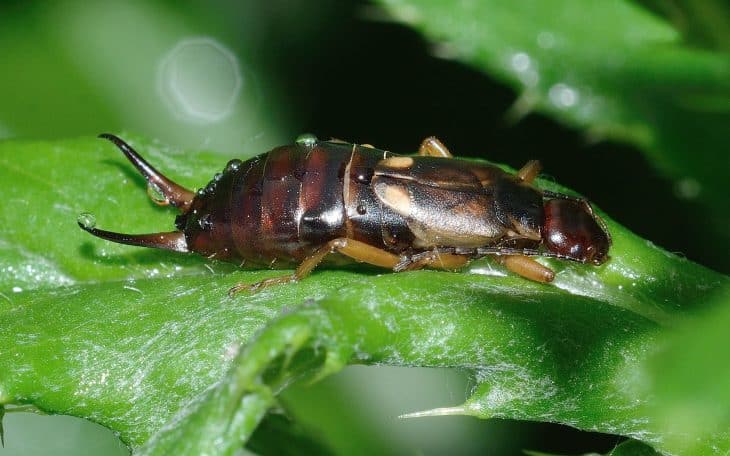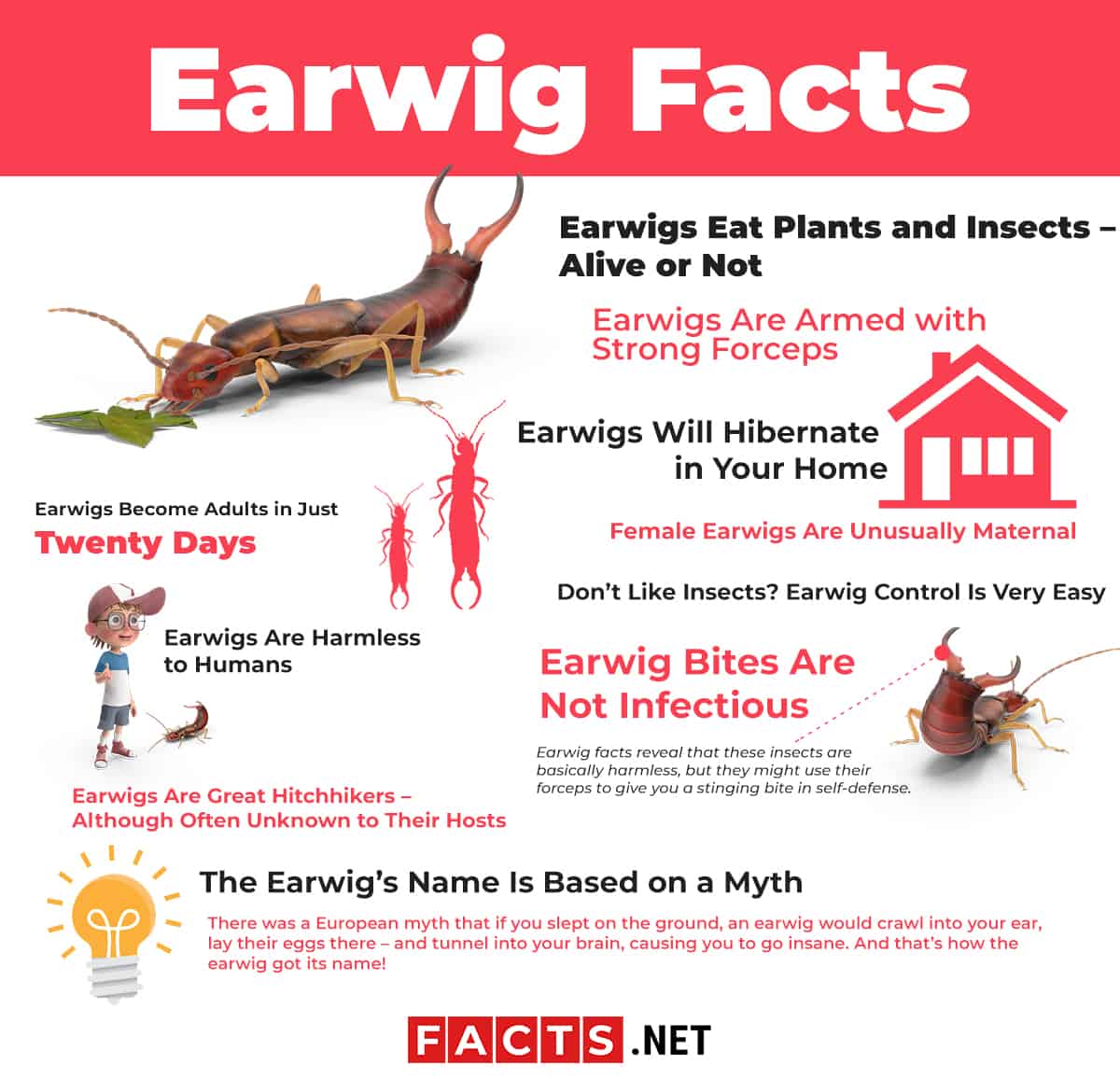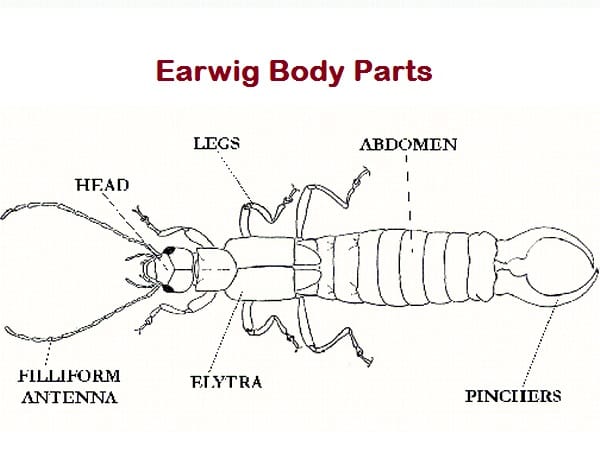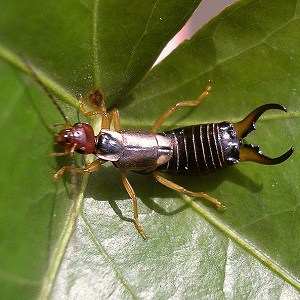
- Scientific Name: Forficula auricularia
- Class: Insect
- Activity: Nocturnal (unless disturbed)
- Types: There are nearly 2,000 species of earwigs across the world
- Location: Worldwide
- Habitat: Earwigs prefer grass and woods
- Lifespan: 1 to 3 years
- Impact: Earwigs do not spread any diseases
- Predators: Frogs, toads, beetles and birds
- Conservation Status: Least Concern
- Diet: Earwigs Eat Plants and Insects – Alive or Not
- Anatomy: Earwigs Are Armed with Strong Forceps
- Lifecycle: Earwigs Become Adults in Just Twenty Days
- Parenting: Female Earwigs Are Unusually Maternal
- Hibernation: Earwigs Will Hibernate in Your Home
- Don’t Like Insects? Earwig Control Is Very Easy
- Earwigs Are Harmless to Humans
- Earwig Bites Are Not Infectious
- Earwigs Are Great Hitchhikers – Although Often Unknown to Their Hosts
- The Earwig’s Name Is Based on a Myth
Earwig Facts Infographics

Earwigs Eat Plants and Insects – Alive or Not
Earwig facts teach us that these bugs are not fussy eaters. Earwigs are omnivores and tend to eat at night. Earwigs eat both plant matter, such as leaves, fruit, flowers, and mold, as well as insects, and they don’t mind whether their dinner is alive or dead. The fact that they are able to chew enables them to eat tough foods, such as other insects. What’s that crawling on your plate?
Earwigs Are Armed with Strong Forceps

Earwigs are long, flat, narrow and dark brown, black, tan, reddish or yellow in color. They can measure anywhere from half an inch to three inches long. Like all insects, they have six legs and a pair of antenna. Some species also have wings and are able to fly. Earwigs’ bodies are divided into three sections. At the end of their body, on the abdomen, they have a set of forceps or cerci that look like pincers or tweezers that they use to catch prey and for defense. You’ll understand what we mean if you try to pick up an earwig. Ouch! Male earwigs have curved forceps, while the forceps of female earwigs are straight. Another form of defense is the yellow-brown liquid that earwigs emit. Although this smells foul, it is actually harmless.
Earwigs Become Adults in Just Twenty Days
Earwigs go through three stages of development or metamorphosis: egg, nymph, and adult. Nymph is the correct term for earwig larvae. An adult female earwig will generally produce two batches of round, creamy colored eggs every year. Each batch of earwig eggs consists of up to 80 eggs! One of the most fascinating earwig facts is that it takes anywhere from 20 to 70 days for an earwig to develop from an egg into an adult. The exact rate of development depends to a large extent on the temperature at the time.
Female Earwigs Are Unusually Maternal
Of all earwig facts, the most endearing is that female earwigs show a maternal instinct, which is almost unheard of in the insect world. The mother earwig will stay with her eggs and nymphs for quite some time, fiercely protecting her offspring. When they hatch, the earwig nymphs are white to pale green in color. Earwig nymphs molt about five times before reaching adult size, and the mother earwig will stay with her baby earwigs until after their second molting session. By this time, the earwigs are able to find their own food and look after themselves.
Earwigs Will Hibernate in Your Home
Earwigs tend to live in dark, moist environments. They can frequently be found in large numbers under logs, leaves, compost, lawn clippings and bark. Earwigs tend to hibernate during the winter months. They can burrow six feet underground to escape the cold. However, one of the more disconcerting earwig facts is that they often prefer the sheltered conditions offered by people’s homes at this colder time of year. They enter houses by crawling through cracks in walls, and tend to prefer rooms that are wet and damp, such as kitchens, bathrooms, garages and basements. You’re not the only one who wants to snuggle inside when it’s cold outside…
Don’t Like Insects? Earwig Control Is Very Easy
One of the most reassuring earwig facts is that if you don’t like the idea of earwigs making themselves at home in your home, there are some very easy steps you can take to control earwigs. Earwigs like to hide under vegetation, so get rid of any piles of grass cuttings, leaves, compost and other vegetable matter around your home. They enter your home by crawling through cracks in the wall, so make sure that you seal any cracks and crevices in your walls, doors, windows and foundations. Check for, and fix, any leakages, as the resulting damp will attract them. Replace all your white light bulbs with yellow ones as the yellow light is less attractive to insects than bright white light. Birds and frogs are their natural predators, so put a birdbath or birdfeeder in your garden. This will definitely keep the creepy crawlies at bay!
Earwigs Are Harmless to Humans
Although earwigs can look quite intimidating with their forceps, they are generally quite harmless. The only risk posed by earwigs to people is the potential invasion of crops, flowers, and other plants. Other than that, there is nothing to fear. In fact, earwigs are quite beneficial because they eat other insects. If you do happen to find one indoors, rest assured that they generally don’t reproduce inside.
Earwig Bites Are Not Infectious

Earwig facts reveal that these insects are basically harmless, but they might use their forceps to give you a stinging bite in self-defense. One of the more reassuring earwig facts is that these bites are not infectious. Earwigs are not poisonous and their bites heal with time. It’s always a good idea to wash the bites with soap and treat them with a disinfectant. Fortunately, earwig bites aren’t contagious. So there’s no need to avoid your friend who picked up an earwig and paid the price!
Earwigs Are Great Hitchhikers – Although Often Unknown to Their Hosts
One of the most interesting earwig facts is that these insects make great hitchhikers. Earwigs rarely fly and they are unable to crawl over long distances. However, they have been able to spread rapidly throughout the eastern and western United States through hitching a ride. Earwigs crawl into hiding places during the night and are then transported via luggage, newspapers, crated merchandise, cut flowers and fresh produce, lumber and building supplies, vehicles, and even the mail. The next time you pack to go on holiday, check your luggage for sneaky hitchhikers!
The Earwig’s Name Is Based on a Myth
There was a European myth that if you slept on the ground, an earwig would crawl into your ear, lay their eggs there – and tunnel into your brain, causing you to go insane. And that’s how the earwig got its name! Although earwigs don’t actually tunnel into your brain, it is possible that you might find one in your ear because they do seek warmth. Earwigs like narrow, warm spaces and the ear canal fits this description. Fortunately, they don’t generally go into bedrooms because they’re dry environments. Is that an earwig in your ear? Sleep tight…
Earwig Facts – Facts about Earwigs Summary
 Earwigs are small nocturnal insects. They contribute to the ecosystem by feeding on decaying plant matter and other insects. They have a quick lifecycle, from egg to nymph to adult. Although earwigs look fierce, they are essentially harmless. However, there are easy tips to follow should you wish to prevent an infestation. Luckily, earwigs don’t live up to their name and don’t have a habit of crawling into people’s ears and damaging their brains.
Earwigs are small nocturnal insects. They contribute to the ecosystem by feeding on decaying plant matter and other insects. They have a quick lifecycle, from egg to nymph to adult. Although earwigs look fierce, they are essentially harmless. However, there are easy tips to follow should you wish to prevent an infestation. Luckily, earwigs don’t live up to their name and don’t have a habit of crawling into people’s ears and damaging their brains.
Was this page helpful?
Our commitment to delivering trustworthy and engaging content is at the heart of what we do. Each fact on our site is contributed by real users like you, bringing a wealth of diverse insights and information. To ensure the highest standards of accuracy and reliability, our dedicated editors meticulously review each submission. This process guarantees that the facts we share are not only fascinating but also credible. Trust in our commitment to quality and authenticity as you explore and learn with us.
